Conservation of 'Gladioli and Roses' by Henri Fantin-Latour
'Gladioli and Roses' 1880 by Henri Fantin-Latour was treated by Claire Shepherd during her postgraduate internship at the Guildhall Art Gallery. The painting needed conservation work before it was displayed in the Guildhall’s exhibition Nature Morte in 2017. We know from an old invoice in the archive that the painting had been damaged in 1963 when it fell from a wall, tearing the canvas in the bottom right corner. At the time a new canvas was adhered to the reverse of the original to support the tear in a process called ‘lining’. The painting was also cleaned, and the area of missing and damaged paint was retouched. Since that time, the area of retouching had darkened with age, and the varnish applied to the paint surface had discoloured to a dark yellow.
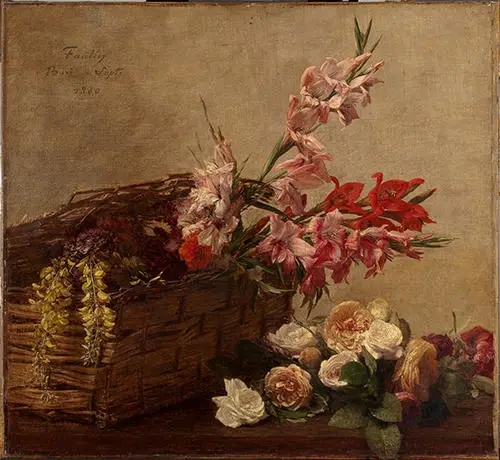
Examination
By looking at a painting in ultraviolet light, it is possible to gain information about it before starting conservation treatment. In this case, a natural resin varnish had been applied to the painting, and this fluoresced a greenish blue in ultraviolet light. It was possible to see some black dots in the lower right corner, and as retouching often appears dark in ultraviolet light, this indicated that this was the area of previous damage caused by the tear.
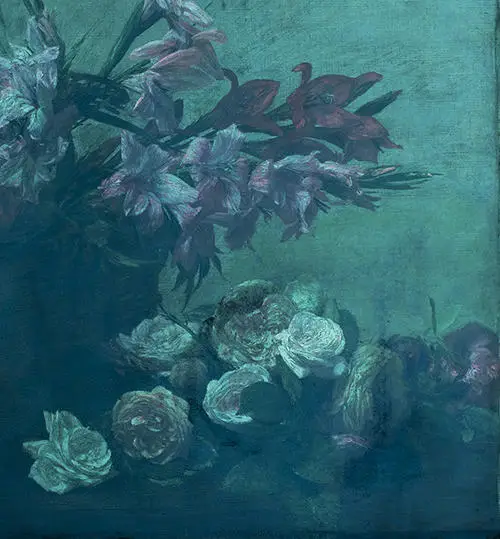
In addition, some areas of pink paint fluoresce a bright orange, including the brushstrokes on the gladioli and the highlight of the rose. This characteristic orange fluorescence relates to the paint layers rather than the varnish and is typical of the red pigment ‘madder lake’ made from the madder plant which is also used to dye clothing.
Cleaning
The thick varnish layer deadened the contrast between the flowers and the background, giving a homogenous effect and an overly warm tone. Because the varnish layer was very thick, it filled in the varied paint texture that is important to the painting’s appearance. Before proceeding with varnish removal the painting was dusted and ingrained dirt was removed with saliva and cotton swabs. Numerous tests were carried out to establish a safe way to remove the varnish from the painting. A bespoke mixture of solvents applied with cotton swabs was used to clean the varnish from most of the painting, however the red pigment used in the carnation and the red gladioli was found to be vulnerable, and needed a different method. This is probably because the red paint film is ‘under bound’ and does not have enough of the oil medium to secure the pigment particles. In these areas a solvent gel was tailored to safely remove the varnish without disturbing the vulnerable pigment particles.
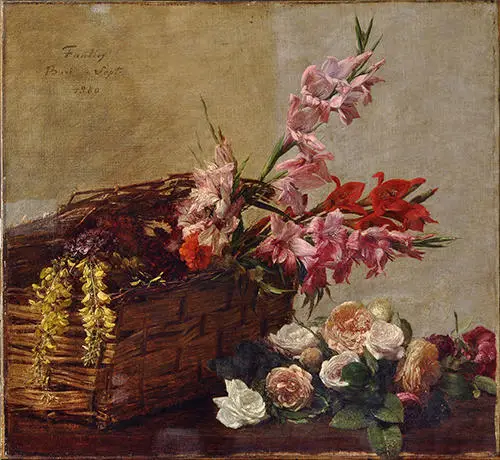
Consolidation
Once the varnish and overpaint had been removed, the extent of the tear became visible. It was found that underneath the overpaint were areas of flaking paint, so these were secured with a weak gelatine solution which was warmed and dried with a heated spatula. Looking at the painting in raking light, you can understand how the disruption in texture draws the eye, even if the retouching is carefully colour matched texture that is very different to the surrounding paint will stand out and draw attention away from the painting composition.
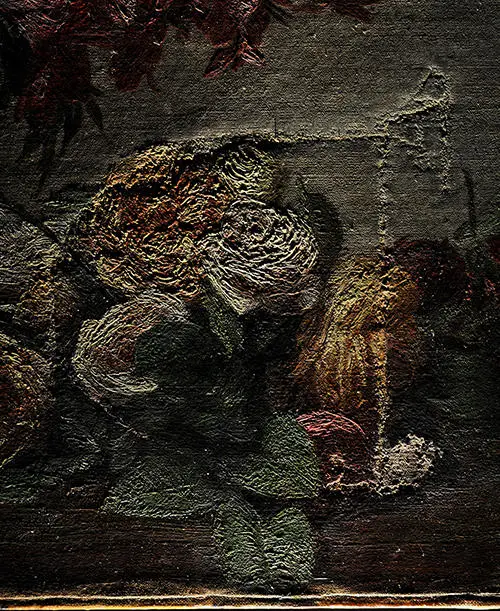
Filling Losses
Once the cleaning of the painting was complete, a new varnish was applied by brush to the paint surface. In this case a synthetic varnish was used because, unlike traditional natural resin varnishes it will not discolour and will remain easily removable in solvents that are safe for the original paint.
The area of lost paint was filled with a chalk putty that was tinted to match the cream coloured ground layer that extends underneath the painting. The paint texture was created in the chalk fill by applying strokes of the thinned putty mixture with a brush, and carving into the putty once it had dried. In order to replicate the fine surface texture of paint silicon moulds were taken of the surface of intact areas of paint. These moulds were then impressed into the surface of the fill during the retouching process.
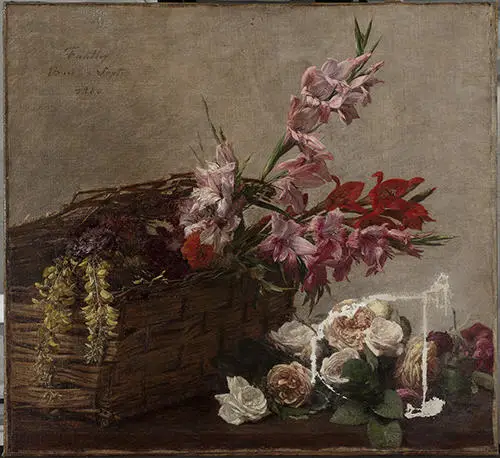
Retouching Losses
The material used for retouching was a mixture of dry pigments and a synthetic varnish medium. This is used because it is capable of imitating the effects of oil paint but is readily reversible. The painting technique used by Fantin-Latour in the background was particularly hard to match, as he had used multiple thin layers of paint in different shades of warm grey, which were then worn down unevenly by the artist to achieve a subtle tonal effect. The backgrounds of paintings can often contain mixtures of many different colours, sometimes known as ‘palette scrapings’, and for this reason can be difficult to colour match.
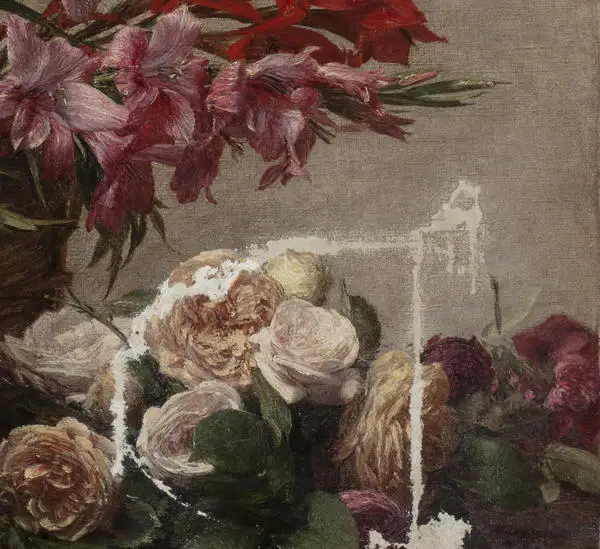
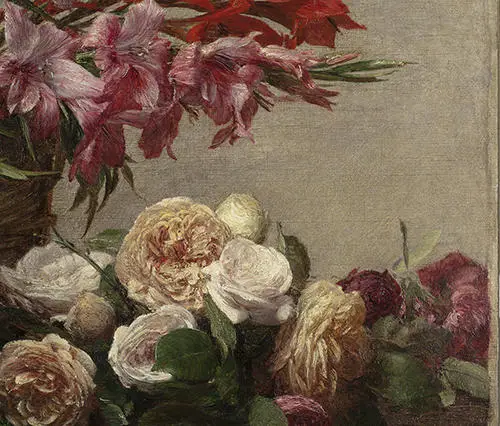
The material used for retouching was a mixture of dry pigments and a synthetic varnish medium. This is used because it is capable of imitating the effects of oil paint but is readily reversible. The painting technique used by Fantin-Latour in the background was particularly hard to match, as he had used multiple thin layers of paint in different shades of warm grey, which were then worn down unevenly by the artist to achieve a subtle tonal effect. The backgrounds of paintings can often contain mixtures of many different colours, sometimes known as ‘palette scrapings’, and for this reason can be difficult to colour match.
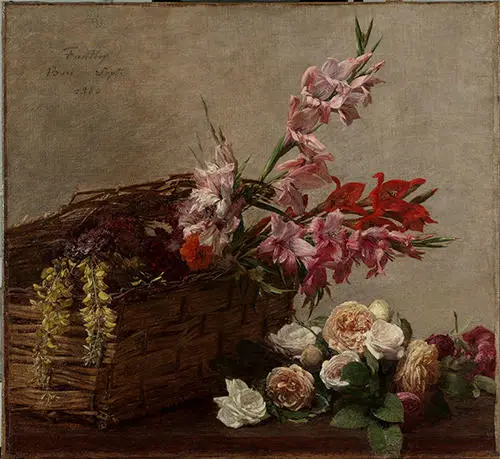
A final layer of varnish was applied to the painting after the retouching was completed. A spray gun was used to distribute a very thin and even layer of varnish across the painting surface, without solubilising any retouching. With this final touch, the conservation treatment was completed and the transformed painting was ready to appear in the Nature Morte exhibition.